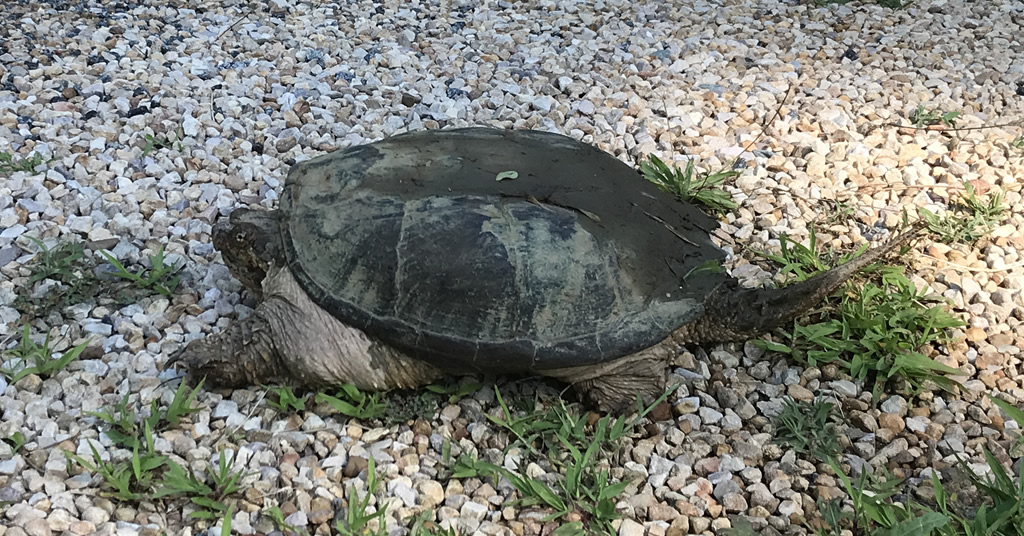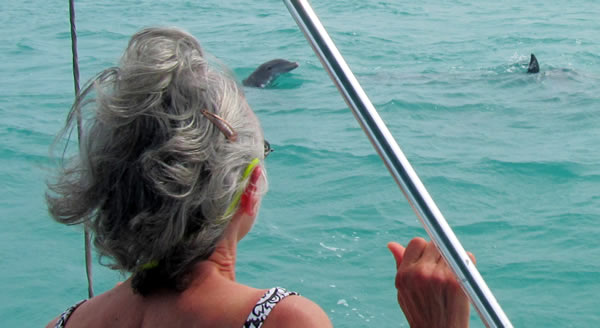WILD WEAVINGS – TURTLE BUTT-BREATHING???
By Sandy Zoumbaris
This Wild Weavings adventure is about my experiences connecting with a huge snapping turtle. The types of intuitive, non-verbal forms of communication I employ in Wild Weavings encounters depends upon the situation and the beings involved. I communicated with this snapping turtle both in-person and remotely. I also used my favorite approach where (with permission, of course) I connect our hearts and weave my consciousness together with their consciousness. This weaving enables me to experience what the other being is experiencing. Here are highlights of my interspecies interactions with this snapping turtle.
I was driving home on a sweltering hot Virginia afternoon and was surprised to encounter a very large snapping turtle poised at the end of a driveway. I pulled over and parked on the road in a manner designed to protect the turtle from being harmed by other vehicles. I exited my car, introduced myself and confirmed that the turtle did have the intention of crossing to the other side of the road. Safely moving a giant snapping turtle is not something I could or should attempt alone. Instead I assured the snapper that I would provide protection from approaching cars while it walked across the road. The turtle posed for a photo and consented to converse with me after reaching safety.
Our interaction was interrupted by the owners of the driveway and their three barking dogs. Two additional cars pulled over and the occupants emerged just to look at the huge turtle up close. The turtle and I agreed to postpone our conversation and connect remotely later on. A knowledgeable science teacher took the lead and “operation turtle transport” was a complete success. Here is a link to more information about safely moving a snapping turtle out of the road: https://www.turtleskingston.com/moving-a-turtle#movesnapping
Using the photo that I took earlier, I easily reconnected to the turtle remotely. I found my friend staying cool in the mud at the bottom of the pond which was her earlier destination. She was still very willing to communicate with me. She confirmed that she was, indeed, a female returning from burying her eggs. When I inquired as to her age, she responded that she had been crossing this road for many seasons. In fact, she had deposited her eggs on that same property since long before the home was even built.
My snapping turtle friend welcomed my request to weave my consciousness with hers so I could experience what her life was like. Immediately, I was aware of the strength of her legs. I realized we were swimming and was surprised at how fast she could travel. I became conscious of the rhythm of the movement of her legs. The words “turtle paddle” came to my mind. The snapper’s body felt very bulky and, at the same time, very buoyant in the water. Although turning corners required coordination between all four legs, I was quite amazed at her agility.

The turtle’s underwater vision was pretty good. I began noticing additional information coming in but was not clear how she was receiving this. Suddenly I got it! Her Shell! WOW! Her shell is a giant receiver. As I grew more accustomed to this really sensitive receiver, I realized she could navigate, feel the flow of water currents, locate food and sense objects throughout the pond from the vibrations she received through her shell from the water.
I asked: “Do you receive the same kind of information through your shell when you are on land?”
Turtle answer: “I use my eyes when I am on land. I also connect to the Earth with my feet, to the Earth grid. That’s how I find my way.”
I suddenly recalled a question about turtles that bothered me in my younger days. I grew up in an area where the ice on the lakes was so thick during the winter that people drove trucks right on the ice! Although I understood that hibernating turtles did not need very much oxygen, I was concerned about how they could get air through the thick covering of ice. An adult informed me that there was a one inch gap between the ice and the water underneath that provided enough room for the turtles to breathe. After studying the edge of the ice around some fishing holes I was not satisfied with this answer. Eventually I just stopped asking the question.
Here it is! My big opportunity to get the answer right from the source!
Me: “How do you breathe when you are hibernating?”
Turtle: “I don’t need to.”
Me again: How do you breathe during the winter?
Turtle again: “I don’t need to.”
I remained perplexed. Does this mean hibernating turtles don’t breathe at all?
I decided to consult google. At the top of my list of search results was an article on the NPR website called “The secret to turtle hibernation: butt-breathing!” It is clearly stated in this article that “When turtles hibernate, they rely on stored energy and uptake oxygen from the pond water by moving it across body surfaces that are flush with blood vessels. In this way, they can get enough oxygen to support their minimal needs without using their lungs. Turtles have one area that is especially well vascularized – their butts.”
So there is the answer for anyone else who wondered and it is called cloacal respiration. I also learned that two-thirds of the turtle species on this planet are at risk of extinction! For more amazing information about turtles and turtle butt-breathing, here is the is the link to the article: https://www.pbs.org/newshour/science/the-secret-to-turtle-hibernation-butt-breathing
My final question for my snapping turtle friend was “Is there anything you want me to tell other humans?” Her reply did not surprise me at all. She said “Slow Down. Slow down and look around you!”
This Wild Weavings post is dedicated to Beth and was inspired by World Turtle Day which happens every year on May 23.
Here is a link for more information about World Turtle Day and how to help protect turtles around the globe: https://www.worldturtleday.org/
Namaste
Sandy

Sandy Zoumbaris
sandy@interspeciesweavings.com
As my journey with Interspecies Weavings continues to unfold, I am passionate about sharing my experiences with the wild ones, the non-domesticated species that also call the Earth home. Wild Weavings is a series of blog posts about these intuitive interspecies explorations.
To view a list of the Wild Weavings posts please click here.
Posts about a variety of topics in intuitive interspecies communication can be viewed here.
